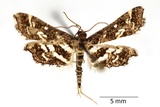Diasemiopsis ramburialis (Duponchel, [1834]) Species
Last modified: Nov. 20, 2025, 3:37 p.m.
The first observation of this very rare and local species in Belgium was in 1961 (LG). From 2021 onwards, several observations became known.
Details
- Classification
- Family: Crambidae > Subfamily: Spilomelinae > Tribus: Nomophilini > Genus: Diasemiopsis > Species: Diasemiopsis ramburialis
- Vernacular names
- Agaatlichtmot (NL)
- First mention in Belgium
- Janmoulle E. 1962e. Diasemia ramburialis Dup. (Pyralidae, Pyraustinae) en Belgique. — Lambillionea 62: 5. On page 5.
- Status
-
Native
For your information, to the best of our knowledge, the first 5 observations after 2004 are listed here:
1) 1 ex. on 12.ix.2021 at Werken (WV), leg. J. Quartier.
2) 1 ex. on 28.ix.2023 at Borchtlombeek (VB), leg. T. Boumon.
3) 1 ex. on 25.x.2023 at Herne (VB), leg. F. Bossuyt.
4) 1 ex. on 25.x.2024 at Kerniel (LI), leg. J. Reekmans.
5) 1 ex. on 27.x.2024 at Maisières (HA), leg. S van Bekkum.
Distribution
Imago
Wingspan 17–22 mm. The moths are gray or brown in color, with ocher dusting, with two large jagged white lines across each wing. The wing edge is outlined in brown and towards the outside there is a hatch of the same color that extends to the fringes of the wing. The palps are brown, the head has a tuft of ocher hair on the upper part, the thorax is brown mottled with white, while the abdomen is brown with thin white lines.
Bionomics
The larvae live in a silken web at the water surface.
Flight periods
The moths can be seen from June till October.
Observed on
- Substrates:
- Unknown
The monophagous larva feeds on Salvinaceae like Azolla filiculoides and possibly other aquatic plants.



